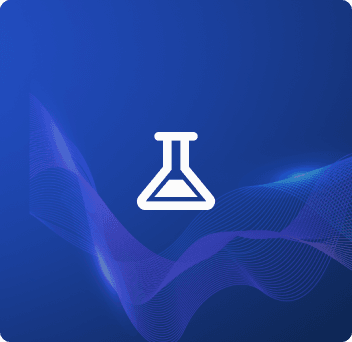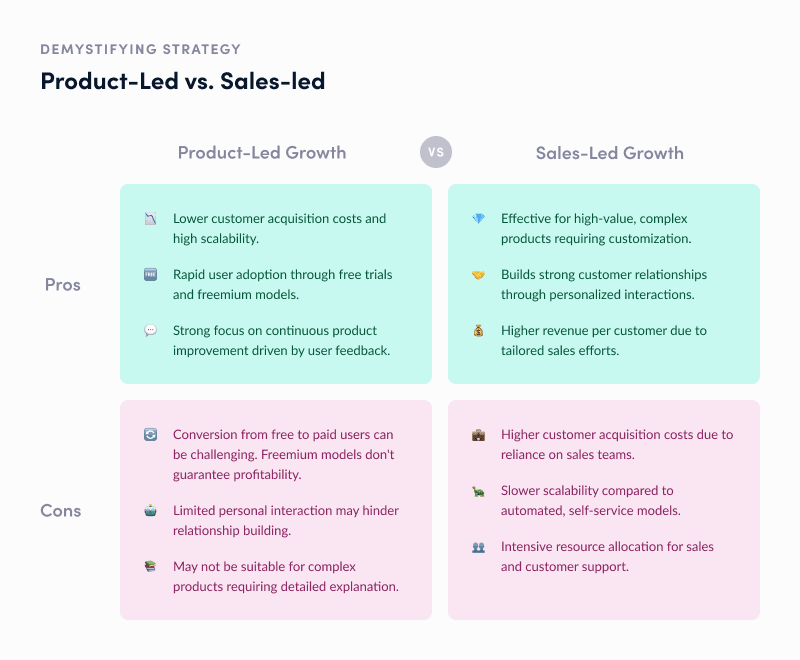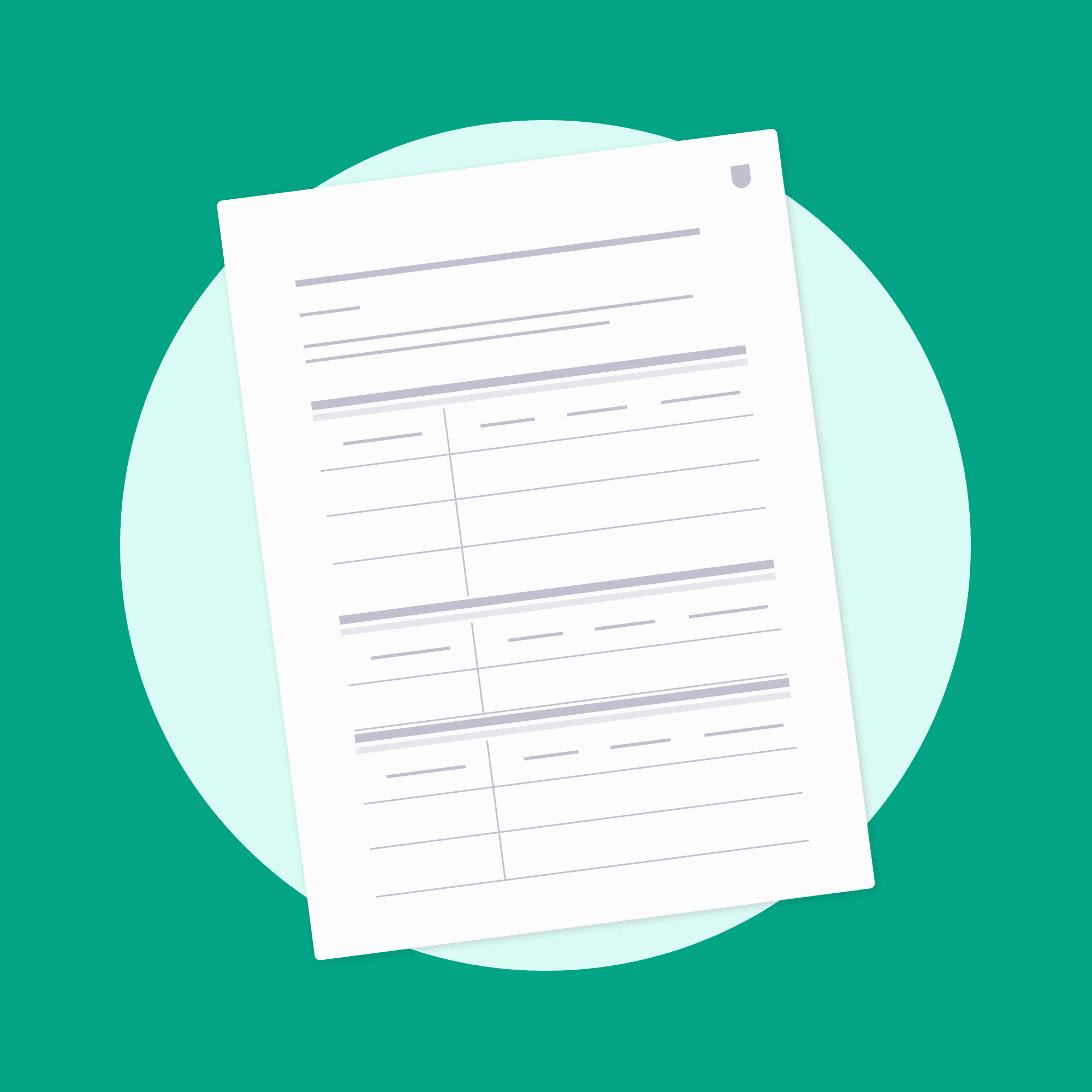Updated: December 5, 2024- 16 min read
In the world of Product, we are confronted with two contradictory truths: Firstly, Product-led companies like Slack and Zoom have reached never-before-seen heights implementing product-led growth (PLG) strategies that forgo sales and marketing, preferring that the product speaks for itself.
On the other hand, in recent years, many of these same PLG companies have expanded their sales and marketing function to adopt, at first glance, what appears to be a more traditional sales-led growth approach (SLG).
Indeed, the merging of these two approaches, formerly deemed total opposites, is happening from both sides. According to McKinsey:
The lines between PLG and SLG are already starting to blur; pure-play PLG companies are hiring sales teams to cater to large enterprises, while more traditional, SLG-driven companies are investing in product-led experiences to help their sales teams prove the value of the product and appeal to a new class of SMB customers.
This hybrid approach has a name: Product-led sales.
In this article, we’ll define product-led growth, sales-led growth, and their love child product-led sales. We’ll discuss the pros and cons of all three and when to implement which strategy.
Product Experimentation Certification
Scale growth through data-driven testing. Use AI to optimize acquisition, retention, pricing, and build a culture of high-velocity experiments.
Enroll now
Understanding Product-Led Growth (PLG)
What is product-led growth? Product-led growth (PLG) is a business methodology where the product itself serves as the primary driver of user acquisition, engagement, retention, and expansion. This approach relies heavily on the product's inherent value to attract and retain customers, leveraging the user experience as a key growth lever.
At its core, PLG is about creating a product so compelling and easy to use that makes it easy for users to start using it right away, encourages them to stay, and motivates them to recommend it to others. Instead of relying heavily on traditional marketing and sales tactics, PLG companies focus on building a product that sells itself through mechanisms known as growth loops.
Key Characteristics of Product-Led Growth
User-Centric Approach: PLG places the user at the center of the growth strategy. This involves deeply understanding user needs, preferences, and pain points to create a product that delivers exceptional value.
Emphasis on Product Experience: The product experience is paramount in PLG. A seamless, intuitive, and engaging user experience is crucial for attracting and retaining users.
Self-Service Model: TTFV (Time to First Value) is minimal so that users start using the product right away and never stop. PLG often employs a self-service model, allowing users to explore, try, and adopt the product independently. This reduces friction in the user journey and enables quicker adoption.
Benefits of Product-Led Growth
Scalability: Because PLG leverages the product as the primary growth engine, it scales more efficiently. As the product improves and gains more users, its growth potential increases without a corresponding rise in sales and marketing expenses.
Lower Customer Acquisition Costs: With the product doing much of the heavy lifting in attracting users, PLG can significantly reduce customer acquisition costs (CAC) compared to traditional sales-led approaches.
High User Engagement and Retention: By focusing on delivering continuous value through the product, PLG strategies often result in higher user engagement and retention rates. Satisfied users are more likely to stay longer and refer others.
Successful Product-Led Growth Companies
Several well-known companies have successfully implemented PLG strategies, demonstrating the effectiveness of this approach. Notable examples of product-led growth companies include:
Dropbox: Dropbox’s freemium model allowed users to experience the product’s value firsthand, leading to organic growth as satisfied users upgraded to premium plans when they hit their storage limit. Dropbox exemplifies the concept of inherent virality: when users share a file, they promote Dropbox’s product.
Zoom: Zoom’s easy-to-use video conferencing platform quickly became indispensable for users, propelling its growth through word-of-mouth and viral adoption. When it mattered most, notably at the start of the COVID-19 pandemic, consumers preferred Zoom’s user experience over established competitors like Skype and Google.
Zoom is probably the most popular example that the best product wins. Despite free and unlimited offerings from Google (Meet) and Microsoft (Teams), Zoom has been able to win more than 40% market share simply because people like using it more.
— SC Moatti, Founding Manager at Mighty Capital and CEO of Products That Count, quoted in TechCrunch
Product-led growth empowers companies to create products that not only meet user needs but also drive sustainable, scalable growth. By focusing on the product experience and leveraging user satisfaction, businesses can achieve significant success in highly competitive markets with high CAC.
Defining Sales-Led Growth (SLG)
Sales-led growth (SLG) is a traditional business strategy where the primary driver of growth is a structured sales process. This approach focuses on building and maintaining personal relationships with potential customers, utilizing a dedicated sales team to guide prospects through the buying journey and convert them into paying customers.
Sales-led growth relies on direct, often personalized interactions between sales representatives and potential clients. The sales team plays a crucial role in educating prospects about the product, addressing their specific needs and concerns, and persuading them to make a purchase. SLG is particularly effective for complex or high-value products that require a detailed understanding and demonstration of their benefits.
Key Characteristics of Sales-Led Growth
Sales-Centric Approach: The sales team is at the forefront of the growth strategy, taking charge of lead generation, nurturing, and conversion. This approach prioritizes building strong, trust-based relationships with potential customers.
Emphasis on Personal Interactions and Relationships: In SLG, success is driven by the ability to establish and maintain personal connections with prospects. Sales representatives engage in direct communication through meetings, calls, and personalized emails.
Structured Sales Processes and Teams: SLG involves a well-defined sales process with clear stages, from lead qualification to closing the deal. Dedicated sales teams are equipped with the necessary tools and training to execute these processes effectively.
Benefits of Sales-Led Growth
High-Touch Customer Engagement: SLG provides a high level of personalized attention, which can be crucial for complex sales and enterprise clients. Sales reps form relationships with customers that build trust and confidence.
Ability to Handle Complex Sales: For products or services that require in-depth explanation and in-depth demos, SLG is particularly effective. Sales representatives can provide detailed information, answer questions, and offer tailored solutions that address specific customer pain points.
Customization and Personalized Solutions: Through direct interactions, sales reps can gather valuable insights into a prospect's unique requirements and offer customized solutions. This personalized approach can lead to higher conversion rates and customer satisfaction.
Examples of Successful Sales-Led Growth Companies
Many companies have achieved significant success through a sales-led growth strategy, particularly in industries where products are complex or high-value. Examples include:
Salesforce: Salesforce's success has been driven by a strong sales team that works closely with businesses to understand their needs and tailor solutions accordingly. Their sales-led approach has helped them become a leader in the CRM market.
Oracle: Oracle uses a sales-led strategy to sell its enterprise software solutions. Their sales teams engage deeply with customers to understand their IT infrastructure needs and provide customized solutions.
IBM: IBM's enterprise solutions often require detailed explanation and customization. Their sales-led growth strategy involves high-touch engagement with clients to ensure their complex needs are met.
Comparing Sales-Led vs. Product-led
Choosing between product-led growth (PLG) and sales-led growth (SLG) is a crucial decision for SaaS companies. Both strategies have distinct advantages and are suitable for different business models and market conditions. Understanding the key differences, situational advantages, and the factors to consider can help companies make an informed choice.
Customer Acquisition and Revenue
Product-Led Growth: In PLG, customer acquisition is driven primarily through the product itself. Users are encouraged to try the product via freemium models, free trials, and self-service onboarding processes. This approach relies heavily on delivering an exceptional product experience that naturally converts users into paying customers.
The operative here is exceptional. As researchers at McKinsey have pointed out, a few standout examples of product-led growth companies far outshine the rest, while the average PLG companies aren’t that different from the average SLG firms.
Although the product-led companies enjoy higher revenue growth rates than their sales-led peers on average, just a select subset of outperformers account for most of that disparity.

Before embracing PLG, companies need to take a hard look at their product and ask themselves if it really can sell itself.
Sales-Led Growth: SLG focuses on direct, personalized interactions between sales representatives and potential customers. The sales team is responsible for lead generation, nurturing, and conversion. This often involves customized demos, consultations, and detailed negotiations to tailor the product or service to the specific needs of each client.
Cost and Scalability
Product-Led Growth: PLG is generally more scalable as it leverages automated and self-service mechanisms to onboard users, leading to lower customer acquisition costs. However, the challenge lies in effectively converting free users to paying customers, which can require sophisticated product analytics and user engagement strategies.
With the Great Reset in tech valuations that followed the COVID-19 pandemic, some PLG companies have had to come up with answers to difficult questions about where their unfettered growth has led. If it still hasn’t turned a profit, some VCs are less likely to invest .
Sales-Led Growth: While SLG can result in higher customer acquisition costs due to the need for a skilled sales team and personalized sales processes, it can be more effective for complex, high-value products that require detailed explanation and customization. This approach can yield higher revenue per customer but may scale more slowly compared to PLG, according to research by Bain.
Customer Relationship and Retention
Product-Led Growth: PLG emphasizes the product's ability to engage and retain users. A strong focus on user experience and continuous product improvements can drive high user satisfaction and loyalty. However, without personal interaction, it can be challenging to build deep customer relationships that form the basis for enterprise expansion.
Sales-Led Growth: SLG builds strong, trust-based relationships through direct, personal interactions. Sales teams can provide tailored support and address specific customer needs, leading to potentially higher retention rates. This approach is particularly effective for enterprise clients who expect a high level of service and customization.

Making a choice: PLG, SLG, or Product-led Sales
Type of Product/Service:
PLG: Best suited for products that are easy to use, with clear, immediate value that can be demonstrated through free trials or freemium models.
SLG: Ideal for complex, high-value products that require personalized explanations and customization.
Target Market and Customer Segments:
PLG: More effective for broad, diverse customer bases, especially in B2C markets where self-service is preferred.
SLG: Better for enterprise customers or niche markets where detailed product customization and strong relationships are crucial.
Business Goals and Resources:
PLG: Suitable for companies aiming for rapid, scalable growth with lower acquisition costs.
SLG: Fits businesses focused on high-touch customer service and higher revenue per customer, willing to invest in a skilled sales team.
Don’t choose: Introducing Product-led Sales
For many, a hybrid approach integrating elements of both PLG and SLG can provide the best of both worlds, ensuring sustainable growth and long-term success.
A Product-led Sales approach applies for the best parts of PLG for B2C and smaller B2B accounts. Companies use data to track signals indicating when these accounts might be ready to upgrade. At that point, the Sales Team springs into action, making contact with engaged users (Product Qualified Leads) and creating the basis for those relationships that have proven vital to enterprise sales.
What is Product-Led Sales?
Product-led sales (PLS) is an approach that combines the strengths of both product-led growth (PLG) and sales-led growth (SLG) strategies to optimize customer acquisition, conversion, and retention. It leverages the product itself to generate initial interest and engagement, while strategically incorporating sales efforts to convert engaged users into paying customers, particularly focusing on high-value accounts.
Product-led sales starts with the product at the forefront, enabling users to experience its value firsthand through free trials, freemium models, or other self-service options. Once users are actively engaged and see the product’s benefits, a dedicated sales team steps in to further nurture these leads and guide them through the purchasing process.
What makes product-led sales different than traditional B2B SaaS sales?
One of the main differences between product-led sales vs. B2B sales has to do with lead qualification.
Actively engaged users mentioned above are considered Product-Qualified Leads (PQLs). Unlike MQLs and SQLs, PQLs have used the product and continue to engage with it, increasing their odds of conversion into a paying customer. Sales teams that only engage with PQLs can be leaner than traditional sales teams because they are dealing with highly qualified leads.
1. Lead Generation
Product-Led Sales:
Product Engagement: In PLS, leads are primarily generated through users’ direct interaction with the product. The strategy leverages free trials, freemium models, or other self-service options to attract users and allow them to experience the product firsthand.
Data-Driven Identification: Leads are identified based on their engagement and usage patterns within the product, making it easier to pinpoint high-intent prospects .
B2B Sales:
Traditional Outreach: B2B sales typically rely on traditional methods such as cold calling, email campaigns, networking events, and referrals to generate leads. The initial focus is on identifying potential clients through research and outreach.
Marketing and Advertising: Lead generation often involves substantial investment in marketing and advertising to attract potential clients and generate interest in the product or service.
2. Sales Process
Product-Led Sales:
User-Initiated: The sales process in PLS is often initiated by the user’s interest and engagement with the product. Sales teams step in after the user has demonstrated significant product usage or interest, making the sales interaction more relevant and timely.
Seamless Transition: There is a seamless transition from product exploration to sales engagement. The sales team’s role is to facilitate the conversion of engaged users into paying customers by addressing specific needs and providing tailored solutions.
B2B Sales:
Sales-Initiated: The traditional B2B sales process is typically initiated by the sales team. It involves reaching out to potential clients, understanding their needs, and persuading them to consider the product.
Structured Approach: B2B sales follow a structured process that includes lead qualification, needs assessment, product demonstrations, negotiations, and closing the deal. This often involves multiple touchpoints and extended engagement periods to build trust and demonstrate value.
3. Customer Engagement
Product-Led Sales:
Self-Service and Product Trials: Customer engagement in PLS starts with self-service options and product trials. Users can explore the product independently, reducing the need for immediate sales intervention.
Proactive Sales Support: Sales teams provide support and personalized engagement based on data-driven insights from product usage. This allows for targeted interventions that are highly relevant to the user’s needs.
B2B Sales:
Direct Interaction: Engagement in B2B sales is characterized by direct interactions between sales representatives and potential clients. This often involves face-to-face meetings, calls, and tailored presentations to build relationships and trust.
Consultative Selling: B2B sales often adopt a consultative approach, where sales representatives work closely with clients to understand their specific challenges and provide customized solutions.
4. Conversion and Revenue Generation
Product-Led Sales:
User-Driven Conversion with Product-Qualified Leads: Conversion in PLS is driven by the user’s positive experience with the product. The aim is to convert PQLs (Product Qualified Leads) into paying customers by initiating contact via the Sales Team.
Scalable Growth: PLS allows for scalable growth by leveraging the product to attract a large user base and then using data-driven sales efforts to convert high-potential users. This model can be more cost-effective and efficient in scaling revenues.
B2B Sales:
Sales-Driven Conversion: In B2B sales, conversion is primarily driven by the sales team’s ability to persuade and negotiate. The process can be more resource-intensive, with a focus on securing high-value contracts and long-term relationships.
Focused on High-Value Deals: B2B sales often target fewer, but higher-value deals. This approach can lead to significant revenue from each customer, but may require more time and effort to achieve each sale.
Implementing a Product-Led Sales Strategy
It’s absolutely possible to have an organization that does both product-led…and sales-led, and they can be very complimentary. But it’s often hard to maintain that balance.
– Rachel Obstler, CPO, Heap
Learn more from Rachel:
Steps to Integrate a Product-Led Sales Strategy into Your Business
Aligning Product and Sales Teams: The synergy between product and sales teams is paramount in executing a successful Product-Led Sales strategy. Establishing open communication channels, shared goals, and a deep understanding of each other's roles fosters collaboration and ensures that product enhancements align with sales objectives.
Utilizing Product Analytics for Sales Insights: Harnessing the wealth of data generated by product usage can offer invaluable insights for sales teams. By analyzing PLG metrics related to feature adoption and engagement rates, sales professionals gain a deeper understanding of customer needs and pain points, enabling them to tailor their approach for more effective selling.
Training Sales Teams on Product Usage and Benefits: Equipping sales teams with comprehensive product knowledge is essential for delivering value to customers. Training programs that immerse sales representatives in product features, functionalities, and use cases enable them to articulate the benefits effectively, building trust and credibility with prospects.
Creating Seamless Transitions Between Self-Service and Sales-Assisted Channels: Striking the right balance between self-service and sales-assisted channels is crucial for catering to diverse customer preferences. Implementing seamless transitions between these channels ensures that users can explore the product independently while having access to personalized support when necessary, optimizing the overall customer journey.
Growth Metrics Cheat Sheet
Master the metrics you need to keep things moving 'up and to the right'! Our Growth Metrics Cheat Sheet covers 45 metrics to measure success at every stage—from acquisition to revenue and referral.
Get the Cheat Sheet
The Goldilocks Approach: When Product-Led Sales Is Just Right
Product-led growth companies like Zoom and Figma are hot. They have disruptive products with best-in-show UX, which makes them prime candidates for viral adoption.
However, the PLG model might be “too hot” for some companies whose products lack the market appeal or intuitive interfaces of the most successful PLG companies.
Sales-led companies are cool as a cucumber: they offer complex and comprehensive solutions. Their products don’t have to be easy to use because key global industries can’t function without them.
SLG Sales Teams draw up detailed onboarding processes for enterprise customers and tailor solutions to their needs. It’s labor-intensive and requires expensive resources. This is why the SLG model has proved “too cold” for smaller, niche companies.
Product-led Sales is “just right” for many companies. It keeps CAC down while providing resources to sales reps to catch the big fish when they do swim by. Product-led sales prioritizes growth while keeping an eye on profitability and revenue.
It might sound less flashy, but the truth is, a lot of the infamous PLG companies have big sales teams nowadays. It makes sense. After all, why choose when you can have both?
Product-Led Growth Micro-Certification (PLGC)™️
Experience the game-changing potential of Product-Led Growth (PLG) as it revolutionizes the role of Product Managers and their impact on organizations.
Enroll now for free
Updated: December 5, 2024



